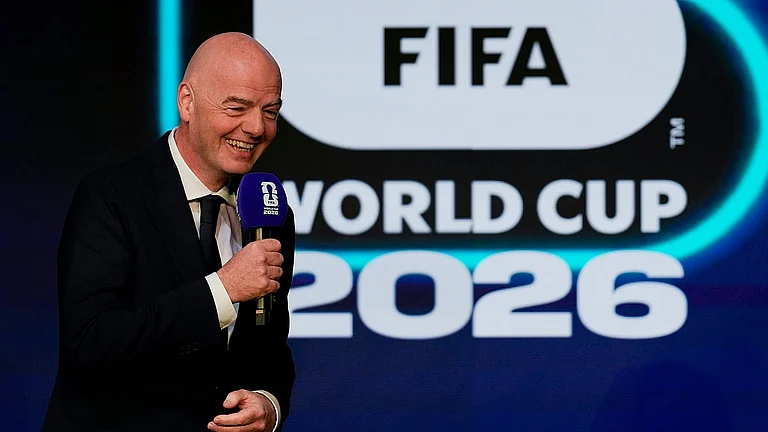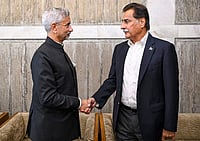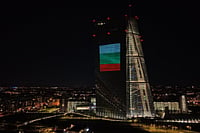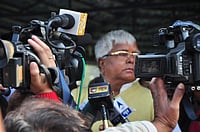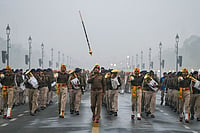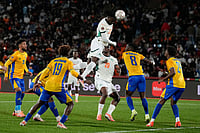Dilip Shanghvi became India’s richest man like he did everything else—with minimum fuss. On March 4, the pharmaceuticals entrepreneur became wealthier than Mukesh Ambani. As shares of Shanghvi-controlled Sun Pharmaceutical Industries (he is founder and managing director), and group company sparc surged on the bourses, his net worth reportedly hit $21.7 billion, a shade ahead of Ambani’s at $21.6 billion.
It is not every day that one witnesses the displacement of Ambani. So the reticent, 60-year-old Shanghvi finds himself back in the limelight when he was barely out of it. In April 2014, Sun Pharma struck a $4bn all-stock deal to buy Ranbaxy Laboratories, the leading generics or off-patent drugs company tainted by serious quality issues, from its Japanese owner Daiichi Sankyo. A merger, when completed, will move Sun up one notch to top dog by market share in India and closer in size to the four generics companies before it in global rankings.
Last month, marking his first known significant personal investment outside pharma, Shanghvi said he would buy 23 per cent in debt-ridden Suzlon Energy for Rs 1,800 crore, followed by an open offer to minority shareholders, throwing a lifeline to beleaguered Suzlon promoter Tulsi Tanti and boosting Suzlon shares (see box). He also applied for a payment bank licence.
Shanghvi is no stranger to fame, thanks to the Rs 16,004-crore Sun Pharma’s rise from start-up to India’s most valuable pharma company in a little over two decades. But it is not something that this low-key Gujarati enjoys. Conversations with Shanghvi watchers are peppered with words such as ‘low-profile’, and ‘publicity-averse’. His manner is reserved; his speech thoughtful, measured.
Indeed, if there was a business equivalent for the boy-next-door, Shanghvi would come close. Industry associates call him Dilipbhai. “Always humble, always simple,” says Rajeev Nannapaneni, vice-chairman and CEO of Hyderabad’s Natco Pharma. Under Nannapaneni’s father, Natco sold a clutch of brands to Sun in 1998 to pay down debt. Since then, Shanghvi is a “supportive friend” who also picked up a minor stake in Natco in 2011. D.G. Shah, secretary-general of the Indian Pharmaceutical Alliance, of which Sun is a key member, says that for all the fame, Shanghvi is “still shy” and “has lots of family values”. For recreation, he is likely to choose the cinema over a page-three party.
And while Narendra Modi—then CM of Gujarat—attended Shanghvi’s son Aalok’s wedding in 2011, observers attribute this to Sun’s stature as a large employer, with factories and a research centre in that state. “Shanghvi does not usually mix with politicians,” says Shah, who is on the phone with the entrepreneur every week.
But don’t let the self-effacing demeanour fool you. “Beneath the soft-spoken, unassuming and unflappable exterior lurks the shrewdest brain in the business,” wrote the late K. Anji Reddy, pharma doyen and founder of Sun competitor Dr Reddy’s Laboratories, in his autobiography. “When he talks, everybody listens,” says Nannapaneni. “He controls the room.” Sun turned down a request to interview Shanghvi for this article, citing the imminent Ranbaxy merger.
Recently, Shanghvi, in an uncharacteristic self-referential statement, likened himself to Eklavya, the tribal boy from Mahabharata who turned skilled archer by observing—undetected—Arjuna train under Dronacharya. “I try to learn from those more successful than I,” he said. It is an apt parallel. He is a keen observer of competition and has professsed “great respect for the Indian entrepreneur’s ability to learn rapidly”.
When he started out, Shangvi was not unfamiliar with the world of drugs; he had done time in his father’s wholesale generic drug distribution business in Calcutta. Yet, he saw this as a different ballgame. The commerce graduate read up on the science and picked the brains of heavyweights, including Yusuf Hamied and Anji Reddy, who ran pharma firms Cipla and Dr Reddy’s.
Over three decades, Shanghvi has built Indian drug industry’s most profitable company on his own terms—focus, cost-control, and a keen eye on the bottomline. As Ranbaxy and Dr Reddy’s paid top dollar for acquisitions, Shanghvi zeroed in on troubled companies that were selling shares or assets for cheap and snapped them up with a view to turning them around. Ambitious announcements, one-upmanship, or bidding wars are not for him. Nor is growth for growth’s sake.
“The biggest lesson that one can learn from Dilipbhai and Sun Pharma is to chase a business opportunity for its value and not because everybody else is doing it,” says Nannapaneni. “They (Sun) wouldn’t pursue a business just because it had a Rs 100 crore turnover,” he adds. “They’d rather do Rs 10 crore of business if it meant Rs 9 crore of profit.” Sun’s profit margins are much higher than peers. “Their standards of operating efficiency are high,” says Nimish Mehta, founder-director of investment advisory Research Delta Advisors.
Sure, there have been problems. It took Sun a three-year tussle with the owners of Israel’s Taro Pharmaceuticals, a financially mismanaged generic drugs maker, to win control. It was a harrowing time, involving lawsuits, shuttling between continents and facing investors. Sun had tripped earlier, in the mid 2000s—albeit temporarily—over disgruntled investors in US-based Caraco Labs, another distressed company it purchased. Ranbaxy too will come with a bucketload of issues—it has poneyed up $500mn to settle charges of covering-up quality defects and four of its five Indian factories are prevented from selling in the US.
Sun has had run-INS with the US drug regulator FDA too. In 2008, Caraco’s facility was found to have metal scrapings in some batches of pills, among other violations. Sun addressed those issues but shut down the factory last year. Sun’s factory in Halol, Gujarat, too was found deficient. However, the FDA is still approving drugs from there, including a recent sparc-innovated product. This, reportedly, was the reason for the spurt in shares of both companies on March 4. Mehta of Research Delta guesses that since some of Sun’s acquired factories are dated, adapting them to meet the escalating demands of the international regulatory system might be challenging.
A couple of years ago, Sun was reported as a potential suitor to three attractive western branded drugs companies. “The branded business brings sustainability and you don’t have to keep thinking of your next product like in the generics business,” says an analyst from a foreign brokerage on condition of anonymity. The risk would be higher, thanks to the relative novelty of the business and the premium paid for it, he said. However, those deals never happened and Sun purchased Ranbaxy. The analyst reckons that perhaps Shanghvi was wary of spooking investors, so reverted to type.
In January, when he was guest of honour at Anji Reddy’s book launch in Hyderabad, I asked Shanghvi what his key challenges were. In his self-deprecating way, he said, “I need to not be responsible for anything.” Being ‘hands-on’ is a Shanghvi hallmark. But clearly, he has to help Sun move beyond him. In 2010, he hired a top professional as CEO. Later, he relinquished the post of chairman to a global generics industry bigwig.
Sun’s ability to succeed in future depends on its managers’ ability “to perform on a much broader scale,” he said. Indeed, Sun’s integration with Ranbaxy, a behemoth with a presence in 43 markets and 21 factories, will test the company’s management at every level at a time when Shanghvi’s personal investments now include renewable energy, a sector with its own pulls and pressures. His biggest challenges, therefore, may still be before him.
***
Pharma Troika A Look At Shanghvi’s Firms
Sun Pharma
- What: Flagship pharmaceuticals business
- Business: Making and selling of patent-expired drugs to India and abroad Largest market is the US, followed by India
- Point to note: Most valuable pharmaceutical company in India
- Rs 16,004 crore Revenues (FY14)
- Rs 2,14,483 crore Market capitalisation
- Rs 3,204 crore net profit (FY14)
Sparc
- What: R&D company from Sun Pharma
- Business: Engages in research of novel drugs and delivery systems that, if successful, can be marketed by Sun Pharma
- Point to note: Recently received US FDA approval for new delivery system of anti-epilepsy pill that reduces frequency of dosage
- Rs 167 crore Revenues (FY14)
- Rs 12,277 crore Market capitalisation
- Rs 30 crore net profit (FY14)
Ranbaxy
(Merger With Sun Not Completed Yet)
- What: Leading India-headquartered generics company purchased by Sun Pharma in $4bn deal in 2014 from Japan’s Daiichi Sankyo
- Business: Making and selling patent-expired drugs in India and foreign markets. Present in more markets than Sun Pharma.
- Point to note: Plagued by quality issues. Four out of five Indian facilities banned from selling into the US by drug regulator FDA.
- Rs 13,268 crore *Revenues (FY14)
- Rs 34,621 crore Market capitalisation *fifteen month period
- Rs 1085 crore *net loss (FY14)
Sources: BSE website, Sun, SPARC, Ranbaxy annual reports
(Gauri Kamath is a pharma and healthcare commentator and writes the blog Apothecurry)









